Phys10
WAVES
A wave- a spreading of disturbances from one place to another, transfers energy
A travelling wave transfers energy from one place to another through some kinds of vibration (eg.: Sound wave- vibration of air particles, EM wave- sinusoidal electric field and mag field at right angles to each other, wave water- vibration of water molecules, wave in rope- vibration in rope)

Transverse waves-direction of disturbance is at right angles to direction of travel of wave, water waves, waves in rope, EM waves

Longitudinal waves-direction of disturbance is in same direction as direction of travel of wave, sound
waves in ground (shock/ seismic waves) consist of both types of waves

for all wave motions, particles of the medium only move up and down (or to and for) while the wave moves on
Describing waves
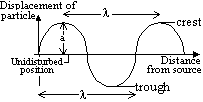
Wave length: dist occupied by one complete wave / dist bet 2 successive crests or troughs
Amplitude: max displacement from undisturbed pos. / height of crest or depth of trough measured from undisturbed pos.
(larger amplitude > large amt of energy carried by wave)
Speed: dist traveled by a crest / any pt on wave in one second
Frequency, # of complete waves/oscillations generated per second / # of crests passing a chosen pt per second (hertz- Hz- S-1)
Period: time take for one complete wave/oscillation [ = T-1]
Wavefront: line or surface joining every particle w/ same displacement and motion (i.e. they are in phase) (eg line joining all the crests of a wave) (direction of travel of wave is always perpendicular to wavefront)
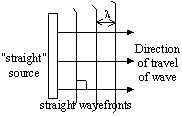
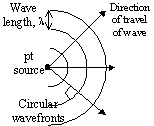
Reflection
Reflection doesn't change velocity, freq or wavelength

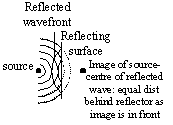
Refraction
| Shallow > deep | Deep > shallow
|
| Speed, v | ^ | Decreases
|
| Wavelength, l | ^ | Decreases
|
| Freq, f | unchanged | unchanged
|
| Direction of wave motion | away from normal | towards normal
|
If the wave approaches a boundary at right angles > no change in direction

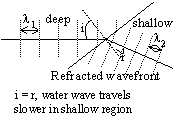
Relation between speed, wavelength and frequency
Speed = dist travelled per second
For one complete oscillation: dist = l (wavelength), time taken = T (period)
λ = T -1: as T = f -1  v = f λ
v = f λ
waves travelling at same speed: shorter wavelength, higher freq [higher freq > larger amt of energy (energy freq)]
SOUND
Sound: form of energy transmitted as a longitudinal wave
Any object which vibrates in a surrounding medium produces a sound

C - compression: molecules pushed together > higher pressure
R - rarefraction: molecules farther apart > lower pressure
λ - wavelength of sound wave: dist bet 2 successive compressions
f - freq of sound wave: # of compressions produced per second (= freq of source)
Speed of sound wave: v = fλ
| MEDIUM | SPEED OF SOUND (m/s)
|
|---|
| Air | ~330
|
| Water | ~1500
|
| Concrete/ iron | ~5000
|
| Steel | ~6000
|
Higher density of medium > faster speed of sound
Speed of sound affected by temp, pressure, humidity
Range of audibility for humans : 20Hz - 20kHz- limits of audibility diminish w/ age
Ultrasonic
Sound w/ freq > 20kHz (higher freq > more penetrative)
-used in echo-sounding system- sonar: used by ships to find depth of sea (speed known, time recorded, dist: x/2)
uses: detects flaws in metals: flaws or scratches > diff amplitude when receiver connected to CRO
spectacles w/ ultrasound produces a sound depending on dist of object producing the echo > help blind ppl
search for oil and gas: hard rock covering oil & gas reflect ultrasound (speed is known, time recorded > dist can be obtained)
breaking kidney stones as it is a narrow beam (easily aim precisely) & it can transfer more energy than an audible sound wave
Measurement of speed of sound in air
sound arrives at 1st microphone > start timing > stop when reaches 2nd microphone > repeat, find av. Time > plot d-t graph, m = speed

Reflection of sound
-sound reflected well by hard plane surfaces, reflected sound forms an echo
reflected sound; loudest when i = r (ie. sound waves obey laws of reflection)
reverberation: prolonged sound due to merging of many echoes- sound in a large hall
reflecting walls: covered w/ sound absorbing materials- polystyrene- to control quantity of reflected sound waves
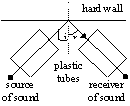
Characteristics of a note
Pitch: depends on freq (pitch freq)
Loudness: depends on amplitude (loudness amplitude)
Quality/ tone / timbre: depends on waveform > 'sound' different (differ in quality, from diff instruments)
-tuning forks emts a 'pure note' - 1 freq only
-notes consist of a mina/ fundamental freq w/ other freq's (overtones/ harmonics: weaker freq: exact multiples of fundamental note)
-# & strength of overtones determine quality of note
Radioactivity
Measurements In Physics
Forces
Energy
Pressure
Optics
Magnetism
Electrostatic Charging
Electricity
Thermal Physics
Back to 'O' level notes index
Back to notes index










 v = f λ
v = f λ

